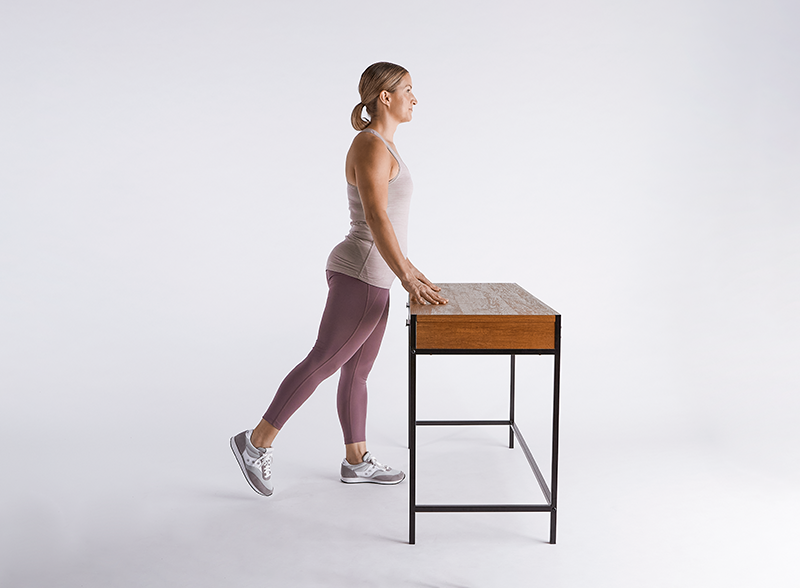How to Do a Standing Hip Extension: A Hinge Health Guide
Learn how to do a standing hip extension exercise to improve lower body strength and stability, plus modifications to make it easier or harder.
Table of Contents
Key Takeaways:
1. Standing hip extensions help strengthen your glutes, hamstrings, and core. This supports movements like walking, climbing stairs, and standing tall.
2. The standing hip extension can reduce hip and back pain, improve flexibility and balance, and ease stiffness from sitting too much.
3. There are a few simple ways to modify the standing hip extension to make it easier or more challenging (see videos below).
Hinge Health offers virtual physical therapy and more to help you incorporate exercises like a standing hip extension into your routine. Learn more.
Tap into pain relief. Anytime, anywhere with our app.
Want to reduce hip pain or build stronger, more flexible hips? The standing hip extension exercise can be a very easy and effective exercise to work into your routine to help improve lower body strength and stability and combat joint pain. It is a versatile exercise that can be adapted to different fitness levels and goals, making it a valuable addition to any routine. Here, learn more about the potential benefits of standing hip extension and how to adapt it to meet your needs.
Our Hinge Health Experts
Dylan Peterson, PT, DPT
What Is Standing Hip Extension?
Standing hip extension is a dynamic exercise that involves extending your entire hip joint by moving your leg backward while standing. It targets the glutes and hamstrings while promoting hip mobility and strength by using more of your hip’s range of motion. (Sitting and being sedentary for long periods of time prevents us from using our full range of motion.)
What Muscles Does Standing Hip Extension Work?
The standing hip extension primarily targets the glutes (butt muscles) and hamstrings (on the back of the thigh). Your glutes provide strength, power, stability, and control in your lower body. Strengthening these muscles can help improve hip mobility during activities like standing, walking, and climbing stairs. It also helps prevent and reduce back and hip pain. Strengthening the hamstrings does the same, and it also helps with things like bending over, squatting, and getting in and out of a car.
Standing hip extension also targets your core, as well as muscles in the back that help with activities such as sitting up straight, lifting heavy objects, and doing twisting or reaching motions.
Benefits of the Standing Hip Extension
Standing hip extension helps with many different daily activities, like walking, climbing stairs, and hiking on uneven surfaces. Other benefits include:
Gluteal muscle activation, which helps you extend your hips fully and sit and stand upright. It also helps with overall lower body strength.
Hip mobility and flexibility, which reduces hip tightness and improves your ability to do functional movements.
Core stabilization, which promotes better balance and overall strength.
Prevention against common injuries such as strains or muscle imbalances in the hips and lower back.
Standing Hip Extension: Exercises and Modifications
The information contained in these videos is intended to be used for educational purposes only and does not constitute medical advice or treatment for any specific condition. Hinge Health is not your healthcare provider and is not responsible for any injury sustained or exacerbated by your use of or participation in these exercises. Please consult with your healthcare provider with any questions you may have about your medical condition or treatment.
Standing Hip Extension
Standing Hip Extension
Standing Hip Extension
Standing Hip Extension
To do a standing hip extension:
Stand with your hands placed on a sturdy surface, like a countertop or table, for balance.
Extend one leg backward and toward the ceiling while keeping your knee mostly straight.
Hold this position, focusing on squeezing your butt muscles as you do so.
Relax your leg and return to your starting position.
Everyone is different, which is why you may need to modify the standing hip extension to meet your needs.
Physical therapy (PT) is for more than just recovering from surgery or injury. It’s one of the top treatments for joint and muscle pain. It helps build strength, improve mobility, and reduce pain. And it doesn't always need to be in person.
Hinge Health members can conveniently access customized plans or chat with their care team at home or on the go — and experience an average 68% reduction in pain* within the first 12 weeks of their program. Learn more*.
Standing Hip Extension Modifications
Standing Hip Extension Modifications
Standing Hip Extension Modifications
Standing Hip Extension Modifications
To make standing hip extension easier:
Limit how far back you move your leg.
Bend your knee slightly as you extend your leg back and up.
To make standing hip extension harder:
Loop a resistance band around your knees or ankles to add resistance to the movement.
How Hinge Health Can Help You
If you have joint or muscle pain that makes it hard to move, you can get the relief you’ve been looking for with Hinge Health’s online exercise therapy program.
The best part: You don’t have to leave your home because our program is digital. That means you can easily get the care you need through our app, when and where it works for you.
Through our program, you’ll have access to therapeutic exercises and stretches for your condition. Additionally, you’ll have a personal care team to guide, support, and tailor our program to you.
See if you qualify for Hinge Health and confirm free coverage through your employer or benefit plan here.
This article and its contents are provided for educational and informational purposes only and do not constitute medical advice or professional services specific to you or your medical condition.
Looking for pain relief? Check if your employer or health plan covers our program
References
Gluteal Muscles. (n.d.). Physiopedia. Retrieved from https://www.physio-pedia.com/Gluteal_Muscles?utm_source=physiopedia&utm_medium=search&utm_campaign=ongoing_internal
Hamstrings. (n.d.). Physiopedia. Retrieved fromhttps://www.physio-pedia.com/Hamstrings?utm_source=physiopedia&utm_medium=search&utm_campaign=ongoing_internal
